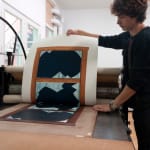Leslie Wayne
Somerset Satin 300gsm Standard White
(76.2 x 55.9 cm)
Further images
Leslie Wayne and Durham Press have completed two new editions, the artist’s first collaborations with the Press since 2003. The works, which combine relief and silkscreen, depict broken, boarded-up windows, presenting enigmatic meditations on artistic illusionism and urgent contemporary issues.
Known primarily for three-dimensional and irregularly shaped abstract paintings, Wayne in recent years has begun to apply these techniques to representational subjects. These works portray architecture, furniture, and everyday things in trompe l’oeil, including storage shelves in her studio, cracked-open closet doors, ladders, and derelict windows. For her new editions with Durham Press, Wayne situates the viewer as if they are standing just outside a seemingly abandoned home but unable to see in. Each print centers on a solitary window, surrounded by wooden siding, with the glass shattered and the opening covered from the interior. Printed wood-grain textures cover the frames and plywood, adding an element of verisimilitude to the works that contrast with their otherwise flattened, stylized surfaces.
Windows, saturated with metaphors of providing views of the world, have been a recurring theme in art of the last century—from René Magritte’s surrealist images to Gerhard Richter’s Shadow Paintings, softened takes on the modernist grid. Robert Delaunay’s series Windows on the City illuminate the ways in which his home, Paris, was changing. Wayne is a New Yorker, and her windows are charged with associations: among them, an infamous policing strategy and a city recovering from 2012’s destructive Hurricane Sandy. Indeed, in the latter case, her windows could be almost anywhere, as natural disasters are occurring globally at an alarming rate.
For Wayne, however, these works don’t necessarily evoke doom. Just as windows are thresholds between two worlds, her prints reflect, in a critical moment, on the nature of reality and illusion, inevitability and potential. As the artist stated, “The idea of a broken window is also an invitation for some sort of renewal. A window can be fixed, new histories can be made.”
Not Forgotten 1 and 2 are printed in editions of 25 and are available directly through Durham Press. For more information on these works, or about previous pieces that Wayne has produced with Durham Press, please contact sales@durhampress.com.











